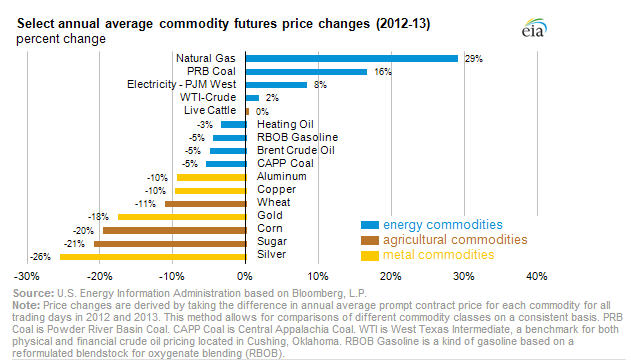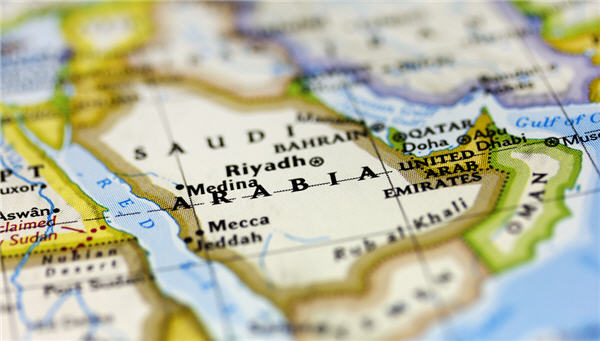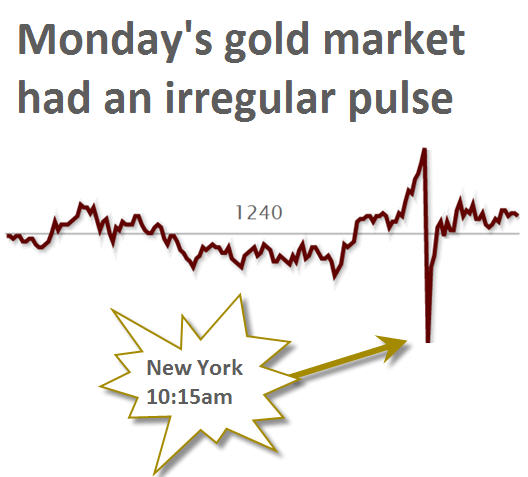Energy commodity prices gained as metals sank in 2013 |
- Energy commodity prices gained as metals sank in 2013
- More good news for Vancouver gold junior on month-long tear
- Why does Saudi Arabia need nuclear power?
- JP Morgan turns ever so slightly bullish on 2014 gold price
- VIDEO: Rolling a 66-tonne Liebherr excavator down a dirt road on a flat-bed truck
- Shorts could be behind gold price flash crash
| Energy commodity prices gained as metals sank in 2013 Posted: 06 Jan 2014 03:56 PM PST The US Energy Information Administration (EIA) has published some interesting information on movements in energy commodity prices during 2013. Natural gas, western coal, electricity, and WTI crude all experienced price gains over the year. Natural gas gained the most, rising by 29%. Meanwhile, North Sea Brent crude oil, various petroleum products, and eastern coal all dropped by about 5%. The Agency also compared energy commodity prices with other sectors. Unlike the energy sector, nonenergy components of the Goldman Sachs Commodity Index – including grains, industrial metals, and precious metals – ended 2013 down 17%, 20%, and 27% from their respective starting points. The divergence between these prices is noteworthy because in the past crude oil futures price changes were often positively correlated with the prices changes of other commodities. "These correlations dropped in the latter half of 2013, indicating that commodity sector prices have been responding to factors in their respective markets rather than broad shifts in expectations of global economic growth, which tend to increase or decrease the prices of all commodities," the EIA writes. |
| More good news for Vancouver gold junior on month-long tear Posted: 06 Jan 2014 03:54 PM PST TrueGold Mining (CVE:TGM) jumped 5% on Monday on heavy volumes, after announcing environmental permit for the Kao deposit at its Karma project in Burkina Faso. By the close the Vancouver-based junior settled at $0.42, up 3.7% on the Toronto Venture Exchange, off its highs for the day. Around 770,000 shares in the $111 million company had changed hands on Monday compared to the usual daily average of 180,000. TrueGold's share price is up 31% over the past month after a strong feasibility study and mining permits for three other deposits at Karma were announced in December. The feasibility calls for a $130 million mine at Karma which is 90%-owned by TrueGold with the Burkina Faso government holding the remainder. Karma's probable reserves are pegged at 949,000 ounces (33.2mt at 0.89 g/t) and the operation could produce 97,000 ounces on average annually for 8.5 years starting end-2015. What makes Karma stand out are all-in sustaining costs of $720 and direct cash costs of $591 thanks to shallow pits and proposed heap-leach extraction and what the company characterizes as "strong gold grades, excellent infrastructure, low power and water requirements, strong recoveries from simple metallurgy and soft, free digging material." TrueGold also owns 100% of the Liguidi gold project in Burkina Faso which last year returned some positive drill results. |
| Why does Saudi Arabia need nuclear power? Posted: 06 Jan 2014 01:36 PM PST Saudi Arabia – known for its massive oil resources – is making a serious push for a different kind of energy: Nuclear power. Last week the country signed a deal with France's AREVA and EDF on a series of initiatives aimed at supporting Saudi Arabia's nuclear energy program. Japan is also preparing a nuclear power pact with the Saudi Kingdom. The deal would allow Japanese businesses to export atomic-related infrastructure to the country, as reported by Japan Times. Saudi Arabia officially started looking into nuclear power in 2006. Along with the other members of the Gulf Cooperation Council (GCC) – Kuwait, Bahrain, the United Arab Emirates, Qatar and Oman – the oil-rich nation led an investigation into the possibility of a nuclear power and desalination program. According to the World Nuclear Association, Saudi Arabia plans on building 16 nuclear power reactors over the next 20 years, with the first scheduled to come on line in 2022. So why does the world's second-biggest oil producer need nuclear power? In 2009, the Kingdom issued a royal decree stating that the "development of atomic energy is essential to meet the Kingdom's growing requirements for energy to generate electricity, produce desalinated water and reduce reliance on depleting hydrocarbon resources." With energy demand growing by about 8% annually, a population of about 26 million and no natural sources of fresh water, the oil-rich country – and the Middle East's biggest oil consumer – actually has a domestic energy shortage. A recent study by the World Economic Forum ranked countries based on how secure they are in terms of energy. Saudi Arabia, despite its oil production of about 9.7 million barrels per day, ranked 91 out of 124 countries. In an interview with NPR last year, author Tom Lippman explained that the rapidly-industrializing desert country's rising population is creating an "insatiable demand for energy because all the water comes from desalination, and the desalination plants are huge consumers of electricity." Saudi Arabia is the world's largest producer of desalinated water, pumping out more than 3 million cubic meters of potable water each day. According to a report by MIT Technology Review, the country uses 1.5 million barrels of oil per day on water desalination. In addition to its water needs, the sun-scorched country also has to power air-conditioning units and all sorts of appliances for its consumer society. "You can imagine what it takes to air-condition Saudi Arabia in the summertime," Lippman said, adding that domestic demand can take as much as 30% of production during the summertime. Saudi Aramco's CEO Khalid al-Falih estimates that "rising domestic energy consumption could result in the loss of 3 million barrels per day of crude oil exports by the end of the decade," the US Energy Information Administration reports. Essentially, Saudi Arabia is looking to diversify its energy mix so that it can devote more oil to exports. In fact, the Kingdom is so keen on saving its oil for export purposes that its goal is to generate almost half of its energy from renewable fuels by 2020. Abundant with oil but also sunshine Nuclear power is only part of the solution. Saudi Arabia also plans on building the world's largest solar powered desalination plant in the city of Al-Khafji. According to Bloomberg, the country's goal is to create a solar industry that will generate a third of nation's electricity by 2032. And its taking this goal seriously: In 2012 the Kingdom announced that it would invest $100 billion in solar power. According to OilPrice, the country was producing only 3 megawatts of solar power at the time. The plan would add 41,000 megawatts within two decades. "We are not only looking for building solar plants. We want to run a sustainable solar energy sector that will become a driver for the domestic energy for years to come," Maher al- Odan, a consultant at the King Abdullah City for Atomic and Renewable Energy said, as reported by OilPrice. |
| JP Morgan turns ever so slightly bullish on 2014 gold price Posted: 06 Jan 2014 11:49 AM PST Predictions for the gold price in 2014 by investment and bullion banks don't vary much in that the majority predict a decline this year. There are bulls – none of them anywhere near raging – like Germany's Commerzbank and Scotia Mocatta which predict a return to $1,400 an ounce. Barclays is somewhere in the middle with a move to $1,350 in the first half but for gold to be back to around $1,270 by end-2014. Merrill Lynch sees the opposite price movement with $1,350 hit at the end of the year. Top bear, along with Goldman Sachs, which is due to bring out revised forecasts soon from its November prediction of a slide below $1,100, is Switzerland's UBS Wealth Management which sees the yellow metal weakening throughout 2014 to hit $1,150. FX Street reports at least one prominent US investment bank has turned more bullish on gold. JP Morgan now predicts an improvement from today's levels, albeit a still modest $40-plus rise: "We expect that the trade policy blocking Indian gold imports will weaken somewhat and we also anticipate that outflows from gold ETFs will stabilize in the coming year, and begin to rise in 2H2014." "A slower pace of gold mine growth in 2014 and 2015 is likely as lower prices feed into project delays and lower capex." "We also still believe that central banks will be net buyers of gold in 2014 and 2015. All this should see prices stabilize and move modestly higher to round $1285/oz by the end of the year." |
| VIDEO: Rolling a 66-tonne Liebherr excavator down a dirt road on a flat-bed truck Posted: 06 Jan 2014 11:10 AM PST It takes a whole lot of axles to transport a big excavator. Mining Mayhem posted this two-part video of a Liebherr R966 being moved in Western Australia. Date and location are not disclosed. Warning, strong language from the people filming. |
| Shorts could be behind gold price flash crash Posted: 06 Jan 2014 11:01 AM PST The gold price climbed back above the $1,240 an ounce level by lunchtime on Monday after a brief plunge of more than $30 an ounce in morning trade in New York dealings. Gold for delivery in February, the most active contract on the Comex division of the New York Mercantile Exchange, dropped from $1,245 to $1,215 within a minute after a massive trade of around 12,000 lots were executed. The order which represents 1.2 million ounces triggered a 10-second halt in trading. Initially it appeared to be a "fat finger" (pressing the wrong button) trade, but the CME Group which runs Comex said in an email to Reuters Hedgeworld "all trades stand and our technology performed as designed." Ross Norman, ex-trader for NM Rothschild and Credit Suisse and owner of bullion brokers Sharps Pixley, told MarketWatch the move "looks to be shorts defending their substantial positions." Short positions – bets that the price will go down – held by large investors or so-called managed money climbed to a record to 82,765 lots or 8,276,500 ounces in the week to December 24 according to the delayed Commodity Futures Trading Commission data released last week. So many big players short of gold could translate into further upside for the metal as commercial traders and hedge funds are forced to cover their positions should gold go higher from here. Norman made the case in April last year that the dramatic $200 an ounce drop in the gold price over two sessions that month was sparked by a short seller's 'shock & awe' 400 tonne trade. |
| You are subscribed to email updates from MINING.com To stop receiving these emails, you may unsubscribe now. | Email delivery powered by Google |
| Google Inc., 20 West Kinzie, Chicago IL USA 60610 | |





0 Comment for "Energy commodity prices gained as metals sank in 2013"